Blog
TRM3.5 Released
TRM3.5.7 was released on 10.11.2021. At first glance, the differences seem to be small. But TRM has become much more performant for very large or high resolution boards (> 10 megapixels per layer, many layers or tens of thousands of laser vias). Also, once again some dialects in the input files are better interpreted.
You may request a test installation here
New Book by Doug Brooks
Doug Brooks has revised his previously self-distributed book on Amazon and it is now available from Artech House.
PCB Design Guide to Via and Trace Currents and Temperatures
Explores how hot traces and vias will be and what board, circuit, design, and environmental parameters are the most important;
● Covers PCB materials (copper and dielectrics) and the role they play in the heating and cooling of traces;
● Details the IPC curves found in IPC 2152, the equations that fit those curves and computer simulations that fit those curves and equations;
● Presents sensitivity analyses that show what happens when environments are varied, including adjacent traces and planes, changing trace lengths, and thermal gradients;
● Explores via temperatures and what determines them, along with fusing issues and whether we can predict the fusing time of traces;
● Readers learn how to measure the thermal conductivity of dielectrics and how to measure the resistivity of copper traces and why many prior attempts to do so have been doomed to failure.
He also uses TRM and outlines the process of model building.
https://us.artechhouse.com/PCB-Design-Guide-to-Via-and-Trace-Currents-and-Temperatures-P2191.aspx
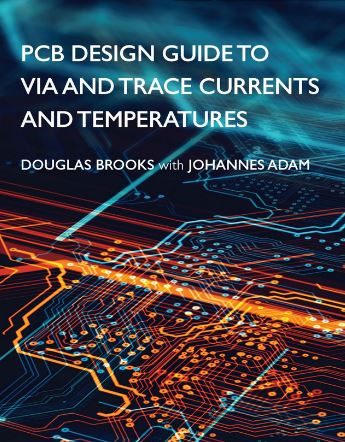
You may also be interested in other titles from the Artech range.
Junction-Ambient controlled by the Layout
The thermal resistance "Junction-Ambient" ΘJA or RΘJA links a temperature node inside the silicon die (Junction) with the surrounding air (Ambient). "Ambient" includes everything around the component, from the pad to the air - i.e. especially the special topology of the PCB. Therefore RΘJA cannot be used to predict the temperature for a specific board. Here are some screenshots from Don't believe the data sheets. Design007 Magazine (September 2020).They show that the heat spreading on a real PCB is not perfect and that it was certainly different on the test PCB of the data sheet.
- This Arduino board is 2-layer. The parallel running tracks can improve and impede the heat spreading.
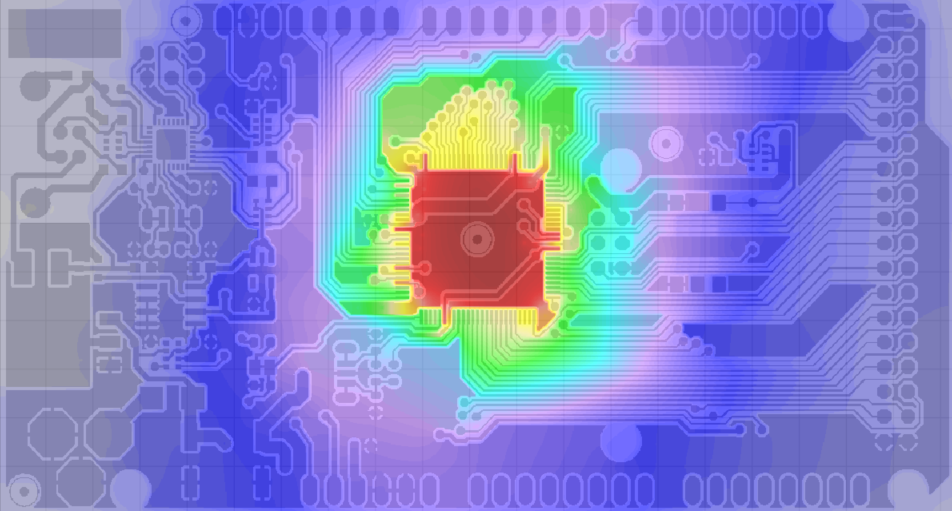
- Even with multilayer boards with solid inner layers, the layout can dominate the heat spreading. In this evaluation board we see that the thermal vias are in fact useless, because they are just as warm as the component, so no heat is removed.

TRM 3.4: Components with electric resistance heat themselves
A TRM release is available: assign a resistor attribute (mOhm) to SMD parts to connect nets or copper geometries. Can be applied it with or without net list. The current goes through it and the voltage drop is adapted to the input value. I^2*R can be used for the heat and add to the Joule heat in traces. Also works in temperature-dependet mode.
- Simple example with resistors. Total resistance is 1 Ohm in each circuit.

- 3 half-bridges (Rdson=3 mOhm each, yellow) with shunt resistors (5 mOhm each, green) share the current.
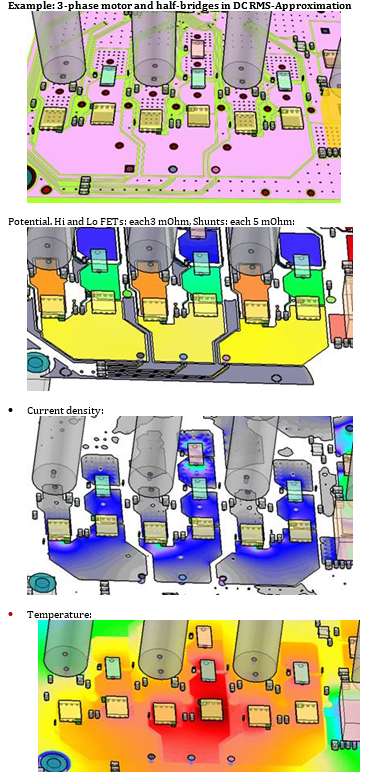
COVID-19 Pandemic Control with TRM3
There are several methods for testing for the COVID-19 virus. A cost effective and fast method is real-time fluorescence analysis (RT-LAMP). More details: Vienna Corona Team
For the a defined reaction of the substrates, all samples in the carrier must be kept at the same temperature. ADAM Research participates voluntarily in the Miriam project by calculating and optimizing the voltage drop in the necessary heating loops and the resulting temperature. In the pilot calculation the heating coil is 18 meters long in a top and bottom part. TRM3 needs only a few seconds for the current density. The geometry comes from an EAGLE design and derived Gerber files. A 1 mm aluminium plate between the top and bottom heating coils has a more uneven temperature distribution than a 2 mm thick plate. The asymmetric distribution is measured qualitatively exactly the same. The aim is to become even more homogeneous and to determine the suitable materials for the next prototypes.
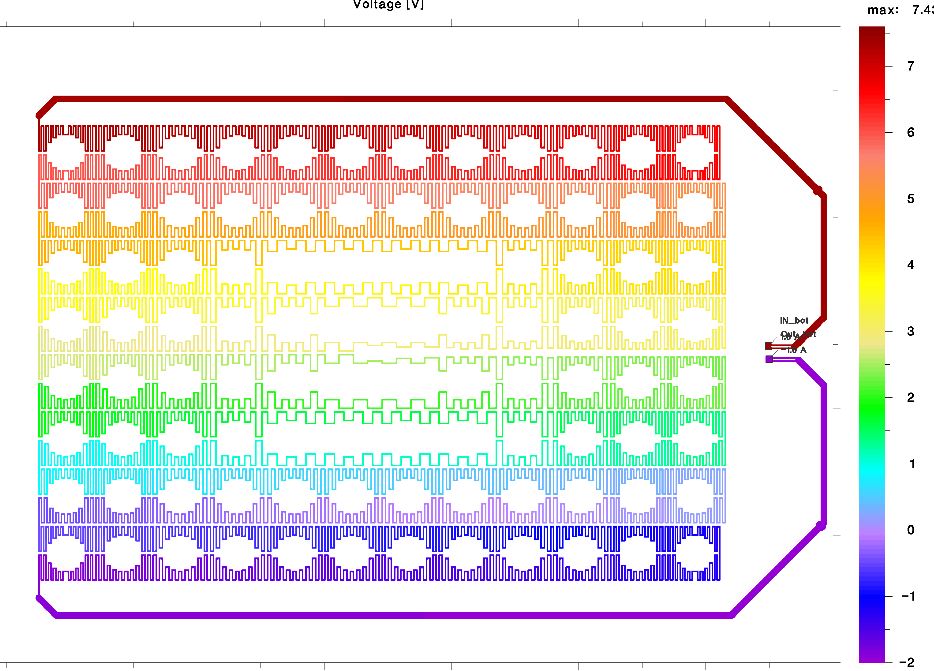
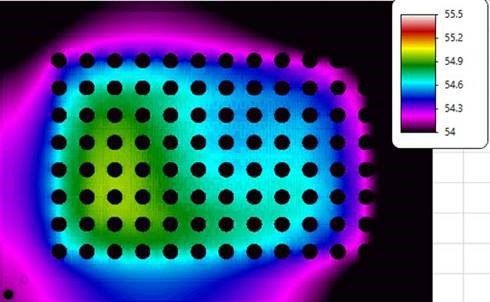
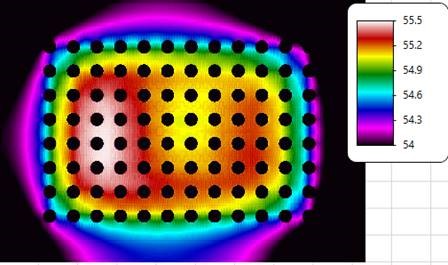
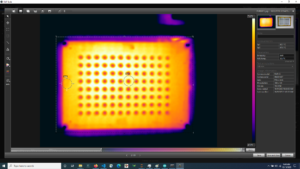
TRM 3.3: More Data, More Color !
More data! Now netlists with their pads/pins can also be imported from other CAD systems, e.g. from Cadence (Allegro, Orcad), Mentor (Pads, Expedition), Zuken (Cadstar, CR8000), Eagle, Pulsonix, KiCad etc. You only have to export the IPC-D-356 file. This makes it much easier to investigate the current carrying capacity of high current applications.
- Import ipc file: creates a table with all the nets and pads found.
- Add Ampere values: either manually or via a .csv file, which could also come from an xls calculation.
- Calculate how the current heats the traces. Of course also transient.
Altium users will still prefer the script. But there have been small updates as well.
More color! The imported Gerber files are no longer just black and white plots, making it difficult to distinguish layers, but are now displayed in color. This results in a fantastic depth effect in the 3D representation, which helps enormously to control the inputs and to understand the results better and to communicate them to colleagues.
Convince yourself: There is a collection of new videos on YouTube
TRM3.2 Released
After almost 2 years of development the new TRM3 is now available as beta roll-out! More elegant and faster than TRM2.
- Altium Import fully automatic or semi-manual. Almost only 2 clicks.
- Scripting for Altium Designer 20 enhanced.
- Input and 3D view of the assembly integrated.
- 3D mesh reconstruction.
- Faster Gerber and Excellon Import.
- Faster calculation of the potential (voltage drop) and current density.
- Inductance matrix of the nets based on 3D current flow
- Heat flux vectors.
- Table of Joule heat per layer and mesh.
- Table of the heat flow balance per component.
- FLIR color bar.
- Result view also 3D.
- Video with Altium Designer
Request a test installation.
Design Service wanted?
Are you looking for external support?
Europe:
We recommend Cieluch Consulting Engineers for works with Altium, Eagle and Cadence. Also with on-site for layout, circuit design and library services.
US, Canada, Mexico:
We recommend Ulisses Castro (Electronic Engineering M.Sc.) (Hardware, Advance Printed Circuit Board Engineering, Signal, Power and Thermal Integrity). Also in combination with TRM.
Passing on the genes: PCB-I Physics
TRM has proven itself over the last years in many electronics companies. It is really quick and easy to set up an electro-thermal simulation model of a printed circuit board. Gerber and drill files are imported, data about the position of the pads or pins and their current values are added and the current carrying capacity, voltage drop and temperature can be calculated. Even without design files you can get interesting insights. This is the perfect stand-alone solution for a developer who needs fast results without overhead and without waiting for colleagues to work together.
But there are the large teams that work simultaneously on the printed circuit board under different aspects or outside departments that have to check functions and feasibility. For such development environments there is now a complementary offer based on ODB++. The Schindler and Schill GmbH and ADAM Research founded a joint venture at the beginning of 2017 called ADAM Labs GmbH. This includes: the CAM and DRC tool PCB-Investigator (sometimes known as EasyLogix) and know-how of TRM.
The product is called PCB-I Physics. and is an implementation of the stationary DC and power solution, not only on CPU, but also on GPU in CUDA. With a good graphics card, the speed gain is enormous. Find out more under
http://www.adam-labs.de (download)
or send a Message with the keyword "Physics". More TRM features and more will be added over the years.
The tools complement each other! Each meets different demands and there is no reason not to use both.